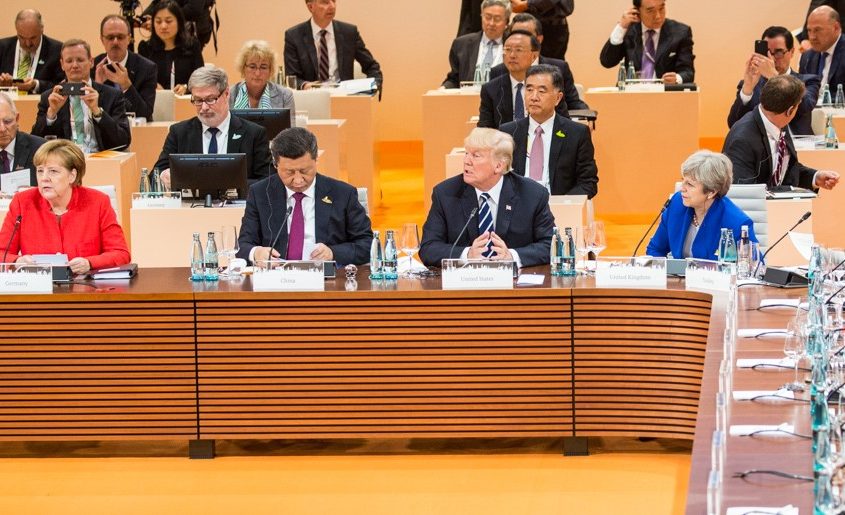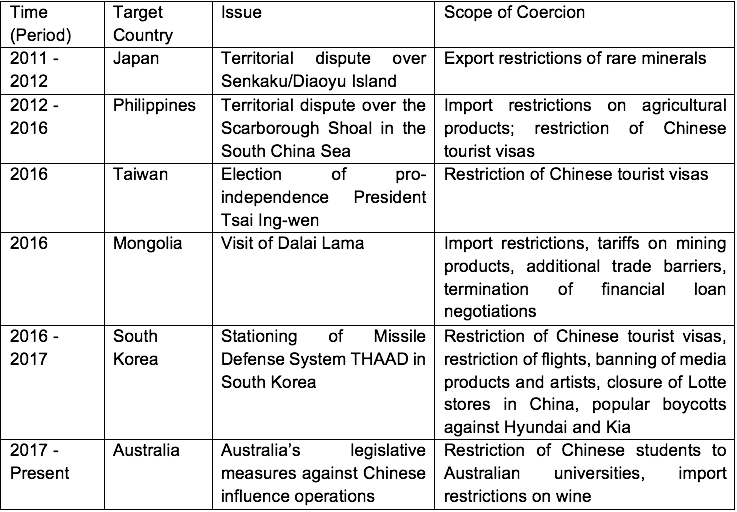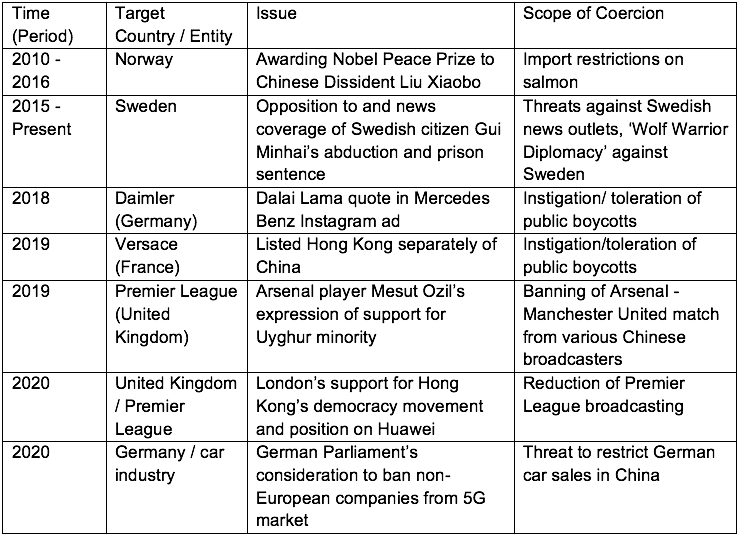
Official White House Photo by Shealah Craighead
Double Down on Liberalism: A Transatlantic Response to Chinese Economic Coercion

Maximilian Ernst
DAAD/AICGS Research Fellow
Maximilian Ernst is a researcher and PhD Candidate in Political Science at the Institute for European Studies of the Vrije Universiteit Brussel (VUB), where he is also affiliated with the KF-VUB Korea Chair. His PhD research seeks to explain Chinese Coercive Diplomacy targeting secondary states in the Asia-Pacific region, specifically how Beijing reconciles the strategic costs of alienating the target states of coercion. Prior to his doctoral studies, Mr. Ernst worked as a Consultant for the Korea Trade-Investment Promotion Agency in Hamburg. He holds an MA in International Security and Foreign Policy from Yonsei University in Seoul and a BA in Chinese Studies from the Johannes Gutenberg University in Mainz.
During his fellowship at AICGS, Maximilian’s research will focus on Chinese security and foreign policy, including economic statecraft targeting U.S. allies both in Asia and in Europe. Building on his PhD research on China’s strategic considerations informing Beijing’s decision to coerce nation states—diplomatically, economically, and militarily—the research at AICGS is set out to identify prospects and opportunities for a transatlantic response to Chinese statecraft targeting U.S. allies. In order to overcome the systemic challenge from China, capitals in Europe, notably Brussels and Berlin, and DC are incentivized to develop a transatlantic China policy that emphasizes the long-term shared interests of the transatlantic community. It is proposed that increased cooperation in key areas such as investment screening, 5G, communications technology, and artificial intelligence bears the opportunity for the transatlantic community to mitigate the adverse economic effects of decoupling, economically and industrially, from China.
The DAAD/AICGS Research Fellowship is supported by the DAAD with funds from the Federal Foreign Office.
China is increasingly resorting to economic coercion to advance political objectives. In the Asia-Pacific regional context, Beijing has repeatedly leveraged economic interdependence to subject regional states to its political and security interests. In Europe, on the other hand, China has thus far relied on subliminal measures to compel individual actors to its will. But as China’s global ambitions and stakes in Europe rise, heavy-handed coercion of the kind that South Korea, Japan, Taiwan, or the Philippines have experienced could soon become a reality in Europe. A case in point is Beijing’s threats to reduce German car sales in China should Huawei be excluded from the German 5G market. In consequence, European policymakers have come to appreciate that China’s rise implicates European security and that economics and politics cannot be separated in diplomatic relations with China. The European Commission’s designation of China as a ‘systemic rival’ and NATO’s acknowledgment that China’s rise implicates European security, both in 2019, are testimony to Europe’s strategic reorientation vis-à-vis China.
In the past, China was able to leverage its economic muscle against targets that were small and lacked a defensive mechanism against economic coercion. However, interdependence goes both ways, and China is as vulnerable to economic pressure as its trading partners. Thus far, Europe and the United States have pursued individual approaches to manage their economic and security relationship with China. But cooperation on the transatlantic level bears much potential to shield individual economies and corporations against Chinese economic statecraft. A new EU-U.S. trade deal that goes beyond the reduction of tariffs and trade barriers would enable both sides to settle the ongoing aircraft-subsidy dispute. Taking existing investment screening mechanisms as a blueprint, the transatlantic trade community could designate critical industries and technologies in which third-party domination of value chains is reduced—the larger the community, the smaller the adverse economic effects. Additionally, proposed transatlantic trade remedies in combination with a blocking statute are geared to alleviate economic damage and to deter coercion from third parties in the first place. Combined with overall strong economic engagement with China in all non-critical industries, such measures are projected to result in close and stable economic and political relations with China for both Europeans and Americans.
Background: China’s Rise and the Phenomenon of Economic Coercion as a Policy Tool
Since China’s emergence as one of the largest and fastest-growing economies in the 1990s, the building of ever-closer economic ties with foreign countries has become a key component of Beijing’s foreign policy. China’s close integration into the global economy and gradual socialization into the liberal international order, notably into the WTO in 2001, promised peace and stability as increasing interdependence would make conflict forbiddingly costly. Assured by the EU’s successful economic and political integration, and with similar attempts well underway in South East Asia with ASEAN, observers of China’s economic rise expected Beijing to have little to gain and much to lose in fundamentally challenging the status quo.
Although some realists predicted China’s rise to pose serious challenges to global stability,[1] conventional wisdom inhered that China’s national interest was first and foremost aligned with its economic interest. This made an openly aggressive Chinese foreign policy unlikely, as it would have threatened the Chinese Communist Party’s (CCP) key source of domestic legitimacy. Prosperity and the expectation that the next generation would lead a better life has been and remains today the CCP’s insurance against the most immediate threat to its leadership: public unrest. Economic growth and international cooperation were a remedy for China’s intrinsic national security predicament—China possesses vast borders with fourteen countries, and even though China is larger and more powerful, the experience of previous dynasties has taught Chinese leaders that fighting a war with more than one neighbor leads to overextension and, more often than not, to a transition of the mandate of heaven to the next emperor and dynasty, a fate that Xi Jinping and the CCP will want to avoid at all costs.
The expectation in the West was that China would, as it began on the path of reform and opening, gradually democratize, ascend into the group of liberal democracies, and become a member of the Kantian foedus pacificum, incapable of aggressive actions toward fellow democracies.[2] The international community put aside worries over occasional transgressions of WTO rules, violations of intellectual property rights, and problematic human rights records in appreciation of Beijing’s maintenance of two-digit growth, alleviation of poverty, and with the expectation that things were overall gradually improving.
The international community put aside worries over occasional transgressions of WTO rules, violations of intellectual property rights, and problematic human rights records in appreciation of Beijing’s maintenance of two-digit growth, alleviation of poverty, and with the expectation that things were overall gradually improving.
Against this background, China’s economic coercion appeared puzzling. Beijing’s coercive measures defy the very predictions of liberalism, while still applying the underlying mechanisms of economic interdependence. Victor Cha and Andy Lim call this ‘Predatory Liberalism,’ whereby China “engages in the global trading order up until the point when it chooses not to […]. Instead, China leverages the vulnerability that interdependence creates in a predatory fashion.”[3]
Cases of Chinese economic coercion abound.[4] In September 2010, Beijing halted exports of rare earths to Japan in response to a confrontation over the Senkaku/Diaoyu islands. When the island dispute flared up again in 2012, Beijing encouraged boycotts and protests against Japanese companies operating in China. In April 2012, Beijing responded to a clash over the Scarborough Shoal with import bans against Filipino bananas and other agricultural produce and Chinese tourist restrictions. When Taiwan elected the pro-independence candidate Tsai Ing-wen as President in 2016, China retaliated by reducing tourist numbers.
In response to South Korea’s 2016 decision to let the United States Forces Korea (USFK) deploy the missile defense system THAAD in South Korea, China launched a host of economic coercive measures lasting one and a half years. Although THAAD is aimed at a potential North Korean missile attack, Beijing believes that the system’s radars increase the United States’ capability to intercept Chinese ICBMs headed for the United States, undermining China’s second-strike capability and damaging global strategic stability. In response, Beijing launched devastating economic coercive measures against Lotte, the South Korean conglomerate that provided a golf course for the stationing of THAAD, forcing Lotte to withdraw its retail brand Lotte Mart from the Chinese market entirely. Beijing furthermore banned South Korean media products and curbed Chinese tourists to South Korea by 48.3 percent in 2017. Travel restrictions alone cost the South Korean economy 15.6 billion USD in lost revenue.[5] Chinese state-run media further encouraged popular boycotts against Korean carmakers Hyundai and Kia, resulting in a 47 percent loss of the Chinese market over six months. With China being South Korea’s most important export market, this translated into an 8.7 percent drop in global sales for Hyundai and Kia in 2017.[6]
The Regional Comprehensive Economic Partnership (RCEP), which was signed on November 15, 2020, by all ASEAN+3 members, New Zealand, and Australia, builds on numerous existing trade agreements among the signatories to create the largest free trade area on the globe. It is notably the first trade deal that includes China, Japan, and South Korea, and it is projected to reduce 90 percent of trade barriers among the fifteen members once it is ratified and provisions come into effect. Since the United States and India are not part of this trade deal, China will likely assume a dominant role and set the standards. Increased interdependence in combination with China’s unbalanced influence within RCEP may only exacerbate Beijing’s coercive potential in the Asia-Pacific regional context.[7]
Figure 1: Selection of Cases of Chinese Economic Coercion in Asia-Pacific

Bribe, Divide, and Conquer Europe?
Another option to coerce the target state to change its behavior is through positive inducements. Audrye Wong argues that Beijing’s positive inducements—in the form of bribes, preferential loans, and investments—commonly have security or political strings attached and refers to them as ‘subversive carrots.’[8] China’s financing of infrastructure projects along the Belt and Road Initiative (BRI) is an example in this vein, which combines Chinese economic and security-political objectives across Eurasia, Africa, and the Indo-Pacific.
In contrast to Asia, Chinese economic statecraft towards Europe has so far been skewed towards this subversive carrot spectrum. Notable exceptions are the embargo against Norwegian salmon in response to awarding dissident Liu Xiaobo the Nobel Peace Prize in 2010, as well as short-term sanctions against states whose leaders received the Dalai Lama.[9] There are cases of retaliation against states and individual companies that, implicitly or explicitly, advocated for Taiwan’s independence or criticized China’s human rights record. But overall, Chinese coercive measures in the European context are dwarfed by the scope of coercion observable in the Asia-Pacific. Instead, Beijing commonly seeks to impact European politics through influence operations and bribes. For instance, the CCP’s United Front uses so-called ‘friendship associations’ across Europe and pays bribes to political elites to influence the EU and member states’ economic and political relationship with China.[10]
China’s 17+1 Forum, a regional cooperation format with Central and Eastern European countries (CEEC) covering cooperation in trade and investments, transport connectivity, finance, agriculture, etc., was a prominent attempt to exploit differences between Brussels and the Eastern periphery. There were fears in Brussels that the 17+1 may not only drive a wedge between East and West Europeans but that Beijing seeks to undermine the EU’s comprehensive strategic partnership with China. A study by the European Parliamentary Research Service finds that high levels of cooperation with China among CEECs correlated with negative attitudes towards the EU and high prioritization of national interests in those countries. The study warns of “China’s growing political influence on CEEC policymakers, businesses, media, civil society, and academia […],” but also points to the growing mismatch between CEECs’ expectations and actual Chinese deliverables.[11] Still, China’s influence-buying campaigns among CEECs have shown results, as demonstrated by Greece’s and Hungary’s refusal to join EU statements condemning China’s human rights records as well as Hungarian Foreign Minister Szijjarto’s opposition to Taiwan’s WHO membership.[12]
The above cases largely fall under the subversive carrot paradigm. But China’s threats in early 2020 to retaliate should Huawei be excluded from the German 5G market are reminiscent of predatory-liberal coercion as witnessed in the Asia-Pacific region. Chinese Ambassador to Germany Wu Ken responded to debates in the German Bundestag on restricting 5G development to European developers with harsh threats. He announced consequences should Huawei be excluded and alleged that the Chinese government would retaliate against Germany’s car industry.[13] During the THAAD retaliation against South Korea, Beijing had already demonstrated that it can significantly damage an entire country’s automobile sector across brands. As mentioned above, Beijing was able to mobilize public boycotts against Hyundai and Kia in 2017, costing these brands as much as 47 percent of the Chinese market. China’s threats against Germany, and more broadly China’s proven ability and readiness to exert industry-wide economic damage on EU members, have to be taken seriously.
Figure 2: Selected Cases of Chinese Economic Coercion in Europe
(including corporate targets, targeted public boycotts, and ‘mere’ threats)

Interdependence Goes Both Ways, And So Does Leverage
Since its accession into the WTO, China has integrated itself into global supply chains and has emerged not only as an important export market but also as a manufacturer and exporter of key technologies and important materials. Over the past fifteen years, Caroline Meinhardt argues, China has focused on indigenous innovation and core technologies in order to strategically manage interdependence with other countries and increase leverage.[14]
However, interdependence goes both ways, and so does the leverage. The European single market is the largest in the world and constitutes China’s second most important export market after the United States. In 2019, 16.9 and 14.6 percent of Chinese exports went to the United States and Europe, respectively.[15] China relies on European imports in key technologies such as specialized machinery and advanced semiconductor manufacturing equipment. The argument of individual European countries’ dependence on China as an export market does not hold up. Many trade statistics neglect intra-European trade, which averages at about 67 percent of EU members’ total external trade. Contrary to allegations that Germany’s export-driven economy was somehow extraordinarily vulnerable to Beijing’s coercion, its exports to China account for a mere 7.1 percent of Germany’s overall export volume, whereas exports to European markets stand at 59 percent.[16]
European dependency on China is not structural but rather confined to individual industries or corporations.
European dependency on China is not structural but rather confined to individual industries or corporations. The German automotive sector, for instance, is indeed heavily invested in and derives most of its revenue from the Chinese market. But German automakers also produce most cars for the Chinese market in China.[17] Should Beijing double down on threats to curb German car sales through public boycotts, this would equally hit the Chinese part of the car manufacturing operation, including Chinese suppliers.
There are, however, critical industries in Europe and the United States in which supply chains heavily rely on components from China. In 2019, around 60 percent of car battery cells worldwide were produced in China, and Chinese companies dominate the global market for graphite, cobalt, nickel, and lithium, the raw materials necessary for battery production. The COVID-19 pandemic further revealed Europe’s over-reliance on global supply chains for pharmaceuticals and medical equipment, which are predominantly sourced from China.[18]
More Than Shared Values: A Transatlantic Trade Deal Based on Shared Interests
The EU and the United States are China’s most important trading partners. In 2019, they made up over 25 percent of China’s total trade.[19] At the same time, China accounted for 9 percent and 14.1 percent of the EU and the United States’ total trade, respectively.[20] Recently, U.S. policymakers have contemplated economic decoupling from China in response to Beijing’s unfair trading practices and to decrease vulnerability to Chinese leverage.[21] Decoupling presents an expedient approach in areas of critical strategic importance or where the United States and Europe overly rely on Chinese dominated supply chains, such as 5G technology, defense technology, pharmaceuticals, and medical equipment. But in the overall trade relationship, the best response to China’s predatory liberalism may just be to double down on liberalism and to increase interdependence. Beijing was able to coerce smaller economies across Asia where it possessed the ability to inflict much more economic pain on the target state than vice versa. Against economic giants like the EU and the United States, Chinese coercion only works in absence of a unified transatlantic approach.
Brussels and Washington have each developed investment screening mechanisms to shield key industries and critical infrastructure from takeovers by Chinese state-owned enterprises.[22] These are meaningful additions to European and U.S. foreign policy toolboxes to respond to Chinese subversive carrots. They demonstrate a U.S. and European capacity to put long-term interests over short-term gains. But trade policies on both sides of the Atlantic have thus far fallen short of mitigating exposure to Chinese predatory liberalism. Yet there is much promise in such an enterprise. A transatlantic China policy, Jeff Rathke and Yixiang Xu argue, would enable the EU and the United States to leverage combined economic size and competitive advantages across industries, increasing consumption and competitiveness vis-à-vis China.[23]
Against economic giants like the EU and the United States, Chinese coercion only works in absence of a unified transatlantic approach.
To deter Beijing from using economic coercion, Europe and the United States need a joint approach that accounts for economic and security interests on both sides of the Atlantic. The best approach to facilitate this objective is a rebooted U.S.-EU trade deal that goes beyond the ambitions of TTIP to reduce tariffs and trade barriers. The next transatlantic trade deal should incorporate a blocking statute with sanctioning mechanisms and trade remedies that insulate individual members of the proposed transatlantic trade bloc from third party coercion.[24] The time for such a transatlantic trade community could not be better; the election of Joe Biden into the White House will provide impetus to reboot Washington’s relationship with partners in Europe. At the same time, there is growing appreciation in capitals across Europe that China is not merely a benign trading partner. Rather, Europeans have learned that Beijing leverages its economic muscle and applies subversive tactics to pursue political and security objectives in its foreign relations. Europeans and Americans are thus encouraged to form a transatlantic consensus on China, based on the readiness to sacrifice individual short-term commercial interests for shared long-term security interests.
A transatlantic China policy that can mitigate the adverse effects of China’s predatory liberalism and subversive carrots could be based on four pillars. First, the United States and Europe could pass a new trade deal that eclipses the scope of TTIP and goes further to encompass a blocking statute and trade remedies able to deter third party coercion. Second, the United States and Europe should deepen cooperation in critical industries and technologies that impact national security. Notably, this relates to 5G and ICT, defense technology, AI, energy storage and electric mobility, rare minerals, pharmaceuticals, and medical equipment. Third, economic interaction with China should be increased across all other non-critical industries as well as those industries that are not threatened by Chinese supply chain domination, thereby increasing interdependence and decreasing incentives for predatory liberalism. Fourth, the United States and the EU could diversify their commercial relations with Asia-Pacific beyond China. South Korean car battery producers, for instance, have doubled their market share in 2020,[25] mitigating China’s dominance in this sector. RCEP furthermore provides a tremendous opportunity for the transatlantic community to engage the region, intensify economic cooperation with all members, diversify supply chains, and increase overall interdependence across the Pacific and the Eurasian continent. This would improve the economic security of European and U.S. allies and strategic partners in the Asia-Pacific and further reduce Beijing’s coercive potential.
Supported by the DAAD with funds from the Federal Foreign Office (FF).
[1] Aaron L. Friedberg, “The Future of US-China Relations: Is Conflict Inevitable?,” International Security 30, no. 2 (2005): 7–45; J. Mearsheimer, “The Gathering Storm: China’s Challenge to US Power in Asia,” The Chinese Journal of International Politics 3, no. 4 (December 1, 2010): 381–96.
[2] Michael W. Doyle, ”Liberalism and World Politics,” American Political Science Review 80, no. 4 (1986): 1151-1169. 1158.
[3] Victor Cha and Andy Lim, “Flagrant Foul: China’s Predatory Liberalism and the NBA,” The Washington Quarterly 42, no. 4 (October 2, 2019): 23–42, 28.
[4] A useful overview is provided by Peter Harrell, Elizabeth Rosenberg, and Edoardo Saravalle, “China’s Use of Coercive Economic Measures” (Center for New American Security, June 2018).
[5] A useful overview of Chinese economic coercion against South Korea following the THAAD dispute is provided by Darren J. Lim and Victor A. Ferguson, “Chinese Economic Coercion during the THAAD Dispute,” Open Forum (Asan Institute, December 28, 2019), http://www.theasanforum.org/chinese-economic-coercion-during-the-thaad-dispute/.
[6] Vince Courtenay, “Missile Dispute Shooting Down Hyundai, Kia in China,” Wards Auto, July 11, 2017, https://www.wardsauto.com/industry/missile-dispute-shooting-down-hyundai-kia-china.
[7] Harding, Robin, and John Reed. “Asia-Pacific Countries Sign One of the Largest Free Trade Deals in History.” Financial Times. November 15, 2020. https://www.ft.com/content/2dff91bd-ceeb-4567-9f9f-c50b7876adce.
[8] Audrye Wong, “China’s Economic Statecraft under Xi Jinping,” Foreign Policy Edition (Brookings, January 22, 2019), https://www.brookings.edu/articles/chinas-economic-statecraft-under-xi-jinping/.
[9] Andreas Fuchs and Nils-Hendrik Klann, “Paying a Visit: The Dalai Lama Effect on International Trade | Elsevier Enhanced Reader,” Journal of International Economics 91 (2013): 164–77.
[10] Toshi Yoshihara and Jack Bianchi, “Uncovering China’s Influence Operations in Europe: How Friendship Groups Coopt European Elites” (Washington, DC: Center for Strategic and Budgetary Assessments, 2020).
[11] Gisela Grieger, “China, the 16+1 Format and the EU” (European Parliamentary Research Service, September 2018).
[12] Yixiang Xu, “Beyond Pandemic: China, 17+1, and the Influence Competition in the CEE Region” (Washington, DC: AGI, May 28, 2020), /2020/05/beyond-pandemic-china-171-and-the-influence-competition-in-the-cee-region/.
[13] Katrin Brennhold and Jack Ewing, “In Huawei Battle, China Threatens Germany ‘Where It Hurts’: Automakers,” New York Times, January 16, 2020, https://www.nytimes.com/2020/01/16/world/europe/huawei-germany-china-5g-automakers.html.
[14] Caroline Meinhardt, “Safe Interdependence: Managing Economic Vulnerabilities,” in Towards a “Principles First Approach” in Europe’s China Policy: Drawing Lessons from the Covid-19 Crisis (Berlin, Germany: Mercator Institute for China Studies, 2020), 37.
[15] Directorate-General for Trade, “European Union, Trade in Goods with China” (Brussels, Belgium: European Commission, May 8, 2020), 8.
[16] Meinhardt, “Safe Interdependence: Managing Economic Vulnerabilities,” 39.
[17] Heymann, Eric. “German Auto Industry: Output in China Exceeds Domestic Production.” DB Research. March 9, 2020. https://www.dbresearch.com/servlet/reweb2.ReWEB?rwsite=RPS_EN-PROD&rwobj=ReDisplay.Start.class&document=PROD0000000000505697#.
[18] Meinhardt, “Safe Interdependence: Managing Economic Vulnerabilities,” 39.
[19] Directorate-General for Trade, “European Union, Trade in Goods with China.”, 8.
[20] United States Census Bureau, “Top Trading Partners” (Washington, DC, 2020), https://www.census.gov/foreign-trade/statistics/highlights/toppartners.html; Eurostat, “China-EU – International Trade in Goods Statistics” (Brussels, Belgium, March 2020), https://ec.europa.eu/eurostat/statistics-explained/index.php/China-EU_-_international_trade_in_goods_statistics#EU_and_China_in_world_trade_in_goods.
[21] Bonnie Girard, “From the Deal to Decoupling: Trump’s Evolution on China,” The Diplomat, September 17, 2020.
[22] European Commission, “EU-China Comprehensive Agreement on Investment” (Brussels, Belgium, February 13, 2020), https://trade.ec.europa.eu/doclib/press/index.cfm?id=2115; James K. Jackson, “The Committee on Foreign Investment in the United States (CFIUS)” (Washington, DC: Congressional Research Service, n.d.).
[23] Jeff Rathke and Yixiang Xu, “A Transatlantic China Policy Can Succeed Where the U.S. and Europe Would Fail Separately” (Washington, DC: AGI, February 13, 2020), /2020/02/a-transatlantic-china-policy-can-succeed-where-the-u-s-and-europe-would-fail-separately/.
[24] European Commission, “Blocking Statute: Protecting EU Operators, Reinforcing European Strategic Autonomy” (Brussels, Belgium, 2020), https://ec.europa.eu/info/business-economy-euro/banking-and-finance/international-relations/blocking-statute_en.
[25] Chris Randall, “Good Year for South Korean Battery Production,” Electrive, September 9, 2020, https://www.electrive.com/2020/09/09/good-year-for-south-korean-battery-production/.









